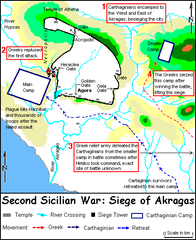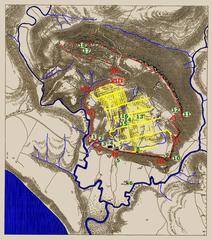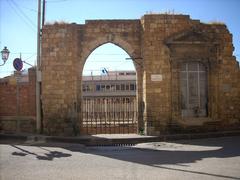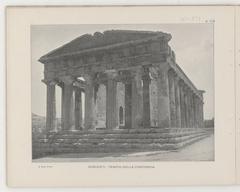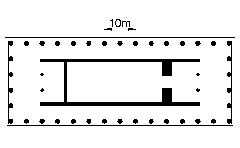
Visiting Valle dei Templi: Hours, Tickets, and Tips
Date: 16/07/2024
Introduction
The Valle dei Templi, or Valley of the Temples, in Agrigento, Sicily, stands as one of the most remarkable archaeological sites in the world. Renowned for its collection of ancient Greek temples, this UNESCO World Heritage site offers a unique opportunity to explore the grandeur of ancient Akragas. Founded in 580 BC by Greek settlers from Gela and Rhodes, Akragas quickly became one of the most prosperous cities in the Mediterranean, a fact reflected in the majestic temples built during the 5th century BC (source). Visitors to Valle dei Templi can witness well-preserved Doric temples dedicated to gods and goddesses like Concordia, Juno (Hera Lacinia), Heracles, and Olympian Zeus, each showcasing the architectural prowess of ancient Greece (source). The site’s historical significance extends through the Roman and Byzantine periods, and ongoing archaeological discoveries continue to shed light on the advanced engineering and daily life of its ancient inhabitants (source). Whether you’re a history enthusiast, an architecture aficionado, or a curious traveler, the Valle dei Templi promises an enriching journey through history. This comprehensive guide provides essential information on visiting hours, ticket prices, travel tips, and nearby attractions to help you make the most of your visit.
Table of Contents
History of Valle dei Templi
Ancient Origins
The Valle dei Templi, or Valley of the Temples, is a remarkable archaeological site located in Agrigento, Sicily. This area was originally founded as the ancient Greek city of Akragas in 580 BC by settlers from Gela and Rhodes. The city quickly grew in wealth and power, becoming one of the most important cities in the Mediterranean. The prosperity of Akragas is reflected in the grandeur of its temples, which were constructed during the 5th century BC, a period often referred to as the “Golden Age” of Akragas.
The Temples
The Valley of the Temples is renowned for its well-preserved Doric temples, which are dedicated to various gods and goddesses of the Greek pantheon. Among the most notable are:
-
Temple of Concordia: Built around 440-430 BC, this temple is one of the best-preserved Greek temples in the world. Its name, Concordia, was given in the 18th century, but its original dedication remains uncertain. The temple’s preservation is attributed to its conversion into a Christian basilica in the 6th century AD (source).
-
Temple of Juno (Hera Lacinia): Constructed in the mid-5th century BC, this temple was dedicated to Hera, the goddess of marriage and childbirth. It suffered damage from a fire in 406 BC during the Carthaginian invasion but was later restored (source).
-
Temple of Heracles: This is the oldest temple in the valley, dating back to the late 6th century BC. It was dedicated to Heracles, the divine hero of Greek mythology. Although it is now in ruins, with only eight columns standing, it remains a significant historical structure (source).
-
Temple of Olympian Zeus: This colossal temple was built to commemorate the victory of the Greeks over the Carthaginians in 480 BC. It was one of the largest Doric temples ever constructed, but it was never completed and now lies in ruins. The temple featured massive statues known as Atlases, which supported the entablature (source).
Roman and Byzantine Periods
Following the Roman conquest of Sicily in 210 BC, Akragas was renamed Agrigentum. The city continued to thrive under Roman rule, although the focus shifted from monumental temple construction to other forms of urban development. During the Byzantine period, many of the temples were repurposed for Christian worship, which contributed to their preservation. For instance, the Temple of Concordia was converted into a Christian basilica, which helped protect it from the ravages of time (source).
Medieval and Modern Times
In the medieval period, the area around the temples was largely abandoned, and the structures fell into disrepair. However, the significance of the site was never entirely forgotten. During the Renaissance, interest in classical antiquity led to renewed attention to the Valley of the Temples. By the 18th and 19th centuries, European travelers and scholars began to document and study the ruins, leading to early efforts at preservation.
In the 20th century, systematic archaeological excavations and restoration projects were undertaken to preserve and protect the site. The Valley of the Temples was declared a UNESCO World Heritage Site in 1997, recognizing its outstanding cultural value and ensuring its protection for future generations (source).
Archaeological Discoveries
Ongoing archaeological work continues to reveal new insights into the history and culture of ancient Akragas. Recent excavations have uncovered residential areas, public buildings, and intricate water management systems, providing a more comprehensive understanding of the city’s layout and daily life. These discoveries highlight the advanced engineering and architectural skills of the ancient inhabitants (source).
Cultural Significance
The Valley of the Temples is not only a testament to the architectural and artistic achievements of ancient Greece but also a symbol of the cultural and historical continuity of Sicily. The site attracts scholars, historians, and tourists from around the world, offering a unique glimpse into the ancient past. The temples stand as enduring monuments to the religious, social, and political life of one of the most influential cities of the ancient Mediterranean world (source).
Preservation Efforts
Preservation of the Valley of the Temples is an ongoing challenge, requiring careful management and conservation strategies. The site is subject to natural weathering, seismic activity, and the impact of tourism. Efforts to protect and restore the temples include regular maintenance, structural reinforcements, and the use of advanced technologies to monitor and mitigate damage. These efforts are crucial to ensuring that this invaluable heritage site remains accessible and intact for future generations (source).
Visitor Information
Visiting Hours
The Valle dei Templi is open to visitors year-round, with seasonal variations in visiting hours. Generally, the site is open from 8:30 AM to 7:00 PM, with extended hours during the summer months. It is advisable to check the official website for the most up-to-date information on opening hours before planning your visit.
Ticket Prices
Admission fees for the Valle dei Templi vary depending on age and nationality. Standard tickets cost around €10 for adults, with discounts available for EU citizens aged 18-25 and free entry for children under 18 and seniors over 65. Combination tickets, which include access to the nearby Archaeological Museum, are also available. Tickets can be purchased online or at the entrance.
Travel Tips
- Best Time to Visit: To avoid the crowds and the heat, consider visiting early in the morning or late in the afternoon, especially during the summer months.
- Guided Tours: Taking a guided tour can enhance your understanding of the historical and cultural context of the site. Many tours are available in multiple languages and can be booked in advance.
- What to Bring: Wear comfortable walking shoes, bring a hat and sunscreen, and carry water, as the site involves a fair amount of walking and there is limited shade.
- Accessibility: The site has some uneven terrain, and not all areas are wheelchair accessible. However, efforts are being made to improve accessibility for all visitors.
Nearby Attractions
- Agrigento Archaeological Museum: Located nearby, this museum houses a vast collection of artifacts from the ancient city of Akragas, providing valuable context to your visit to the Valley of the Temples.
- Scala dei Turchi: A stunning white limestone cliff located along the coast, offering breathtaking views and a unique natural experience.
- Historic Center of Agrigento: Wander through the charming streets of Agrigento’s historic center, where you can find beautiful churches, local markets, and traditional Sicilian cuisine.
Conclusion
The Valle dei Templi is a testament to the rich cultural heritage of Sicily and the enduring legacy of ancient Greece. From its majestic temples to its ongoing archaeological discoveries, the site offers an unparalleled journey through history. Whether you’re a history enthusiast, an architecture aficionado, or simply a curious traveler, a visit to Valle dei Templi promises to be a memorable experience. Be sure to plan your visit with the provided information to make the most of your time at this extraordinary historical site.
FAQ
Q: What are the visiting hours for Valle dei Templi? A: The site is generally open from 8:30 AM to 7:00 PM, with extended hours during the summer months. Check the official website for the most current information.
Q: How much do tickets cost to enter Valle dei Templi? A: Standard tickets cost around €10 for adults, with discounts for EU citizens aged 18-25 and free entry for children under 18 and seniors over 65. Combination tickets are also available.
Q: Are guided tours available at Valle dei Templi? A: Yes, guided tours are available in multiple languages and can be booked in advance to enhance your visit.
Q: Is the Valle dei Templi accessible for visitors with disabilities? A: The site has some uneven terrain and limited wheelchair accessibility, but efforts are being made to improve access for all visitors.
Q: What should I bring when visiting Valle dei Templi? A: Wear comfortable walking shoes, bring a hat and sunscreen, and carry water, as the site involves a fair amount of walking and there is limited shade.
Call to Action
Plan your visit to Valle dei Templi today and immerse yourself in the rich history and cultural heritage of this extraordinary site. For more information and updates, follow us on social media and download our mobile app.
References
- Exploring Valle dei Templi - History, Visiting Hours, and Ticket Information. UNESCO World Heritage Centre. Retrieved from https://whc.unesco.org/en/list/831/
- Exploring Valle dei Templi - History, Visiting Hours, and Ticket Information. Britannica. Retrieved from https://www.britannica.com/place/Valley-of-the-Temples
- Discover the Valle dei Templi - Visiting Hours, Tickets, and Historical Insights in Agrigento. Ancient History Encyclopedia. Retrieved from https://www.ancient.eu/Valley_of_the_Temples/
- Essential Visitor Tips for Exploring Valle dei Templi in Agrigento - Tickets, Hours, and More. Visit Sicily. Retrieved from https://www.visitsicily.info/en/valley-of-the-temples/
- Archaeological Discoveries. Archaeology Magazine. Retrieved from https://www.archaeology.org/issues/388-2009/features/8115-italy-agrigento-akragas

